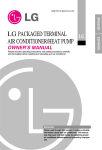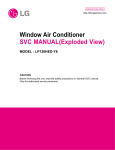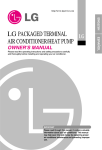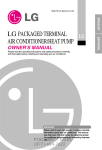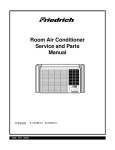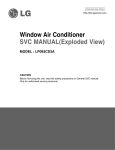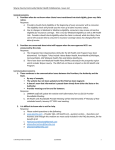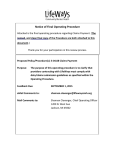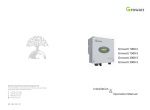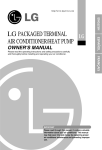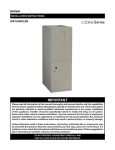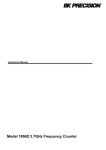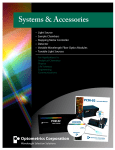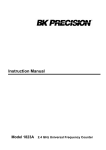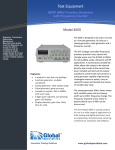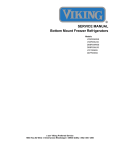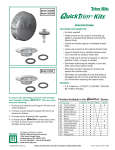Download LG Packaged Terminal Air Conditioner
Transcript
PACKAGED TERMINAL AIR CONDITIONER /HEAT PUMP TECH SHEET Schematic Diagram NEUTRAL LIVE WH BK In part "A", there are 3 types. Disconnect from Electrical Supply Before Servicing Unit GN/YL TB3 Electrical Requirements 1. Do not use an extension cord with this unit. 2. When the unit is in the OFF position, the power supply to the electrical controls is still energized. 3. Disconnect the power to the unit before servicing the unit. 4. Remove the power cord from the wall receptacle. 5. Remove or turn off the protective device (fuses or circuit breaker). BK1 RD BK2 BL BK3 RD BK4 BL TB4 BK OR TB1 WH TB2 WH Type.1 BK OR OUTDOOR FAN MOTOR WH BK OUTDOOR FAN MOTOR INDOOR COIL THERMISTOR INDOOR AIR THERMISTOR BK OR(BR) YL BK BL RD OR(BR) YL BL OR(BR) YL Type.3 FUSE- Use a time-delay fuse or circuit breaker. Refer to the nameplate for proper power supply requirements. OUTDOOR FAN MOTOR "A" BK OR(BR) YL F INDOOR AIR THERMISTOR BK BL RD OR(BR) YL INDOOR COIL THERMISTOR OUTDOOR FAN MOTOR BK RD BL COMP BK BL RD OR(BR) YL RD OR(BR) YL In part "B", there are 2 types. Type.1 HERM R Self-Diagnosis BK Type.2 Wirings including installation of the receptacle must comply with the NEC and local codes, local regulations. 208, 230, and 208/230 VOLT UNITS These units are equipped with a three-prong grounding plug on the power supply cord which must be plugged into a matching properly grounded three-prong wall receptacle for your protection against possible shock hazard. If such an outlet is not present, one must be installed by a qualified electrician in accordance with the National Electrical Code and local codes and ordinances. NOTE: DO NOT USE AN EXTENSION CORD on 208, 230, and 208/230 Volt units. BK BL RD OR(BR) YL INDOOR FAN MOTOR BK RD BL BK BL RD OR BR YL BL RD OR BR YL GN/YL OLP FUNCTION: If the unit has a malfunction, a green OPERATION LED located on the Display PCB used by the unit to indicate the errors. USE: If the customer has to register a complaint to the service center, he can be very clear about registering the complaint that what is happening & by referring the user's manual the customer can clearly define the problem. So that the engineer should go fully prepared with the prescribled tools to be used regarding that problem. It also keeps the customer aware about the unit. Here are some of the problems defined below for which the LED indicates by flashing number of times the error has been reconrded against it. The errors are the mentioned which is as follows: ON OFF Fault Codes CH 01 CH 02 CH 03 CH 04 CH 05 CH 06 CH 07 Normal No power / failed board Indoor Air Thermistor Error Indoor Coil Thermistor Error Outdoor Air Thermistor Error (PIHP Only) Outdoor Coil Thermistor Error (PIHP Only) Mode Error Setpoint Error Bad Thermistor Wiring "B" INDOOR FAN MOTOR BK BL RD OR BR YL BL RD OR BR YL GN/YL Type.2 INDOOR FAN MOTOR FAN CAPACITOR GN/YL Additional Controls The additional controls are located behind the option cover of control box. The standard settings will be in the OFF position. The authorized servicer has to check switches and ensure the switches are in the desired position. REMOTE ON ON ON ON ON ON OFF 5 OFF 6 OFF 7 ON OFF LOCAL OFF OFF OFF 1 2 3 4 Remote/Local Energy Saver Temperature Limit 1 Temperature Limit 2 Temperature Limit 3 PTAC/PTHP UNIT TYPE BK BL RD OR BR YL BK RD OR BR YL Temperature Limiting Temperature Limiting can save money by limiting the lowest temperature for cooling and the highest temperature for heating. The temperature limiting is controlled by switches #1 - #3. This temperature limiting is not available with the Remote Wall Thermostat. Temperature Limit #1 Temperature Limit #2 Temperature Limit #3 OFF OFF ON OFF Cooling Operation Heating Operation OFF Lowest Temp. 54° F (12.2° C) Highest Temp. 86° F (30.0° C) Lowest Temp. 54° F (12.2° C) Highest Temp. 86° F (30.0° C) OFF 56° F (13.3° C) 86° F (30.0° C) 54° F (12.2° C) 84° F (28.9° C) OFF ON OFF 58° F (14.4° C) 86° F (30.0° C) 54° F (12.2° C) 82° F (27.8° C) ON ON OFF 60° F (15.5° C) 86° F (30.0° C) 54° F (12.2° C) 80° F (26.7° C) OFF OFF ON 62° F (16.6° C) 86° F (30.0° C) 54° F (12.2° C) 78° F (25.5° C) ON OFF ON 64° F (17.7° C) 86° F (30.0° C) 54° F (12.2° C) 76° F (24.4° C) — Replacement of the refrigeration cycle. 1. When replacing the refrigeration cycle, be sure to discharge the refrigerant system using a refrigerant recovery system. If there is no valve to attach the recovery system, install one (such as a WATCO A-1) before venting the refrigerant. Leave the valve in place after servicing the system. 2. After discharging the unit completely, remove the desired component, and unbraze the pinch-off tubes. 3. Solder service valves into the pinch-off tube ports, leaving the valves open. 4. Solder the pinch-off tubes with service valves. 5. Evacuate as follows. 1) Connect the vacuum pump, as illustrated Figure 1. 2) Start the vacuum pump, slowly open manifold valves A and B with two full turns counterclockwise and leave the valves closed. The vacuum pump is now pulling through valves A and B up to valve C by means of the manifold and entire system. COMPLAINT Fan motor will not run. ON ON 66° F (18.9° C) 86° F (30.0° C) 54° F (12.2° C) 74° F (23.3° C) ON ON ON 68° F (20.0° C) 86° F (30.0° C) 54° F (12.2° C) 72° F (22.2° C) #6 OFF OFF #7 OFF ON Unit Type Cooling+Electric Heater+Heat Pump Cooling+Electric Heater OR ON ON OFF ON Heat Pump Only Cooling Only Troubleshooting Guide In general, possible trouble is classified in two causes. The one is Starting Failure which is caused from an electrical defect, and the other is Ineffective Air Conditioning caused by a defect in the refrigeration circuit and improper application. Unit is running but cooling is ineffective Ineffective Cooling Check of cold air circulation for smooth flow. Dirty indoor coil (Heat exchanger) Check of outdoor coil (heat exchanger) & the fan operation. Check heat load increase. Unexpected residue Check gas leakage. Overloaded Circuit Malfunction of fan Repair gas leak. Clogged of air filter Obstruction at air outlet Replacement of unit if the unit is beyond repair. Adjusting of refrigerant charge Correct above trouble Check clogging in refrigeration circuit. Repair clogging in refrigeration circuit. Check of inside gas pressure. Malfunction of compressor Satisfactory operation with temperature difference of inlet & outlet air 44.6~50˚ F (7~10˚ C) Replacement of compressor Fails to Start Check power source. Check circuit breaker and fuse. Gas leakage of feeler bulb of thermostat Check control switch setting. T/P C 3) Operate the vacuum pump for 20 to 30 minutes, until 600 microns of vacuum are obtained. Close valves A and B, and observe the vacuum gauge for a few minutes. A rise in pressure would indicate a possible leak or moisture remaining in the system. With valves A and B closed, stop the vacuum pump. 4) Remove the hose from the vacuum pump and place it on the charging cylinder. See Figure 2. Open valve C. Discharge the line at the manifold connection. 5) The system is now ready for final charging. 6. Recharge as follows : 1) Refrigeration cycle systems are charged from the high-side. If the total charge cannot be put in the high-side, the balance will be put in the suction line through the access valve which you installed as the system was opened. 2) Connect the charging cylinder as shown in Figure 2. With valve C open, discharge the hose at the manifold connection. 3) Open valve A and allow the proper charge to enter the system. Valve B is still closed. 4) If more charge is required, the high-side will not take it. Close valve A. 5) With the unit running, open valve B and add the balance of the charge. a. Do not add the liquid refrigerant to the low-side. b. Watch the low-side gauge; allow pressure to rise to 30 lbs. c. Turn off valve B and allow pressure to drop. d. Repeat steps B and C until the balance of the charge is in the system. 6) When satisfied the unit is operating correctly, use the pinch-off tool with the unit still running and clamp on to the pinch-off tube. Using a tube cutter, cut the pinch-off tube about 2 inches from the pinch-off tool. Use sil-fos solder and solder pinch-off tube closed. Turn off the unit, allow it to set for a while, and then test the leakage of the pinch-off connection. SUB CON2 CON1 Improper thermostat setting Defect of compressor capacitor. CONDENSER (HIGH PRESSURE SIDE) OBM-2504U1 Main : 340 C1 : 52.8 OBM-2202U1 Main : 813 C1 : 52 C2 : 39.6 SUB : 208 C2 : 52 SUB : 264 Replacement of fan motor Regular but fails to start Irregular motor insulation ( ) Replacement of compressor (locking of rotor, metal) Replacement of compressor (Motor damaged) Wire disconnected or connection loose Connect wire. Refer to wiring diagram for terminal identification. Repair or replace loose terminal. Capacitor (Discharge capacitor before testing.) Test capacitor. Replace if not within ±10% of manufacturer's rating. Replace if shorted, open, or damaged. OR Will not rotate Fan blade hitting shroud or cross flow fan hitting scroll. Realign assembly. S1(C1) S2(C2) YL Units using slinger ring condenser fans must have 1/4 to 5/16 inch clearance to the base. If it is hitting the base, shim up the bottom of the fan motor with mounting screw(s). RD(LOW) BL(MED) BK(HI) Resistance of coil (at 75°C, Ω) OBM-3018U1 Main : 165 C1 : 48.2 C2 : 48.2 SUB : 63.0 Check fan motor bearings; if motor shaft will not rotate, replace the motor. Revolves on overload. Fan motor runs intermittently MANIFOLD GAUGE Pay attention to any change from high speed to low speed. If the speed does not change, replace the motor. Fan motor noise. Grommets Check grommets; if worn or missing, replace them. Fan If cracked, out of balance, or partially missing, replace it. Turbo fan If cracked, out of balance, or partially missing, replace it. Loose set screw Tighten it. Worn bearings If knocking sounds continue when running or loose, replace the motor. If the motor hums or noise appears to be internal while running, replace motor. COMPLAINT Compressor will not run, but fan motor runs. CAUSE Check voltage. See the limits on the preceding. page. If not within limits, call an electrician. Wiring Check the wire connections, if loose, repair or replace the terminal. If wires are off, refer to wiring diagram for identification, and replace. Check wire locations. If not per wiring diagram, correct. Rotary Check for continuity, refer to the wiring diagram for terminal identification. Replace the switch if circuit is open. Thermostat Check the position of knob If not at the coldest setting, advance the knob to this setting and restart unit. Check continuity of the thermostat. Replace thermostat if circuit is open. Capacitor (Discharge capacitor before servicing.) Check the capacitor. Replace if not within ±10% of manufacturers rating. Replace if shorted, open, or damaged. Compressor Check the compressor for open circuit or ground. If open or grounded, replace the compressor. EXTERNAL VACUUM PUMP A EVAPORATOR (LOW PRESSURE SIDE) Figure 1-Pulling Vacuum LOW HI Overload COMPRESSOR B REMEDY Voltage B B Check voltage. See limits on this page. If not within limits, call an electrician. Test capacitor. Check bearings. Does the fan blade rotate freely? If not, replace fan motor. A A CHARGING CYLINDER C Irregular motor resistance ( ) Check switch continuity. Refer to wiring diagram for terminal identification. Replace switch if defective. < Outdoor motor > COMPOUND GAUGE SEE INSETS BELOW Defect of fan motor capacitor. Improper wiring Replacement. Rotary switch RD(LO) Resistance of coil (at 75°C, Ω) CAPILLARY TUBE Improper wiring. Irregular motor resistance ( ). Irregular motor insulation ( ). Check voltage to rotary switch. If none, check power supply cord. Replace cord if circuit is open. BL(MID) Loose terminal connection. Check capacitor. Power supply cord BK(HI) YL Equipment needed: Vacuum pump, charging cylinder, manifold gauge, brazing equipment. pinch-off tool capable of making a vapor-proof seal, leak detector, tubing cutter, hand tools to remove components, service valve. Only fan fails to start. Drop of power voltage. Check voltage at outlet. Correct if none. POWER M SUB Check control switch. Only compressor fails to start. No power MAIN If high vacuum equipment is used, just crack valves A and B for a few minutes, then open slowly with the two full turns counterclockwise. This will keep oil from foaming and being drawn into the vacuum pump. REMEDY < Indoor motor > BR CAP. OFF CAUSE Check the compressor overload, if externally mounted. Replace if open. (If the compressor temperature is high, remove the overload, cool it, and retest.) ROOM AIR CONDITIONER VOLTAGE LIMITS NAME PLATE RATING MINIMUM MAXIMUM 208/230V 187V 252V Figure 2-Charging P/No.: 3850A20594H


